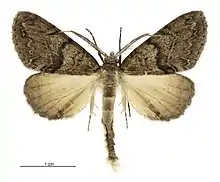| Pseudocoremia suavis | |
|---|---|
 | |
| Male | |
 | |
| Female | |
| Scientific classification | |
| Kingdom: | |
| Phylum: | |
| Class: | |
| Order: | |
| Family: | |
| Genus: | |
| Species: | P. suavis |
| Binomial name | |
| Pseudocoremia suavis Butler, 1879 | |
Pseudocoremia suavis, the common forest looper, is a species of moth in the family Geometridae.[1] It is regarded as being endemic to New Zealand.[1][2] In 2007, however, the moth was found in west Cornwall, Great Britain, the first time it has been found outside of New Zealand.
Range
The common forest looper is endemic and common throughout New Zealand feeding on many species of trees and shrubs.[2] An unidentified specimen was caught on 15 April 2007 by Tony James at a regular garden light trap, approximately, near Tregonning Hill in the parish of Breage.[3] By October a further four were caught in the same garden; although it took a year before the specimens were identified by the Natural History Museum, London. The garden is adjacent to a small plant nursery and it is possible the moth may have been introduced on plants from another British nursery.[4]
Life cycle
The descriptions below are mainly from an individual female caught on 30 October 2015 in west Cornwall and retained for breeding. The larvae were reared at 15–20 °C, in air-tight plastic boxes.[3]
Egg
The female laid sixty eggs, some individually but most in groups of fourteen to twenty along the edge of tissue paper. When laid the eggs were dark green turning to brownish purple after seven days. After seventeen days the larvae hatched eating the egg cases.[3] In New Zealand breeding experiments many females laid over one hundred eggs.[2]
Larva
The larvae feed on a wide range of trees and shrubs and have caused serious defoliation in exotic plantations in New Zealand on two occasions. In the 1950s and early 1960s in mostly Monterey pine (Pinus radiata) plantations in Canterbury (including Eyrewell Forest), and in the 1970s, Douglas fir (Pseudotsuga menziesii) plantations on the North Island.[3]
Pupa
The pupae were 10–12 mm long, green at first turning mahogany-brown within two days. Pupation took two to three days.[3]
Imago
The wingspan is about 30 mm.
Food plants
The larvae feed on a wide range of plants in New Zealand including southern beech (Nothofagus spp.), podocarps and kanuka (Kunzea ericoides).[2][5] They also feed on European gorse (Ulex europaeus). Some of the Cornish larvae initially fed on Leyland cypress (Cupressus × leylandii) and were moved to Scots pine (Pinus sylvestris) in the second instar when they became unhealthy. They also fed on box (Buxus sempervirens) and yew (Taxus baccata) but preferred Scots pine.
References
- 1 2 Gordon, Dennis P., ed. (2010). New Zealand inventory of biodiversity: Kingdom animalia : chaetognatha, ecdysozoa, ichnofossils. Vol. 2. p. 458. ISBN 978-1-877257-93-3. OCLC 973607714. OL 25288394M. Wikidata Q45922947.
- 1 2 3 4 Berndt, Lisa; Brockerhoff, Eckehard G.; Jactel, Hervé; Weis, Tanja; Beaton, Janette (December 2004). "Biology and rearing of Pseudocoremia suavis, an endemic looper (Lepidoptera: Geometridae) with a history of outbreaks on exotic conifers". New Zealand Entomologist. 27: 73–82. CiteSeerX 10.1.1.694.4615. doi:10.1080/00779962.2004.9722127. S2CID 84358294.
- 1 2 3 4 5 Brown, David C G; Barron, Scott J (2016). "The Captive Rearing of Common Forest Looper Pseudocoremia suavis Butler, 1879". Atropos (57): 17–21. ISSN 1478-8128.
- ↑ James, Tony. "Common Forest Looper Pseudocoremia suavis". UKMoths. Retrieved 28 December 2016.
- ↑ "PlantSynz - Invertebrate herbivore biodiversity assessment tool: Database". plant-synz.landcareresearch.co.nz. Retrieved 11 July 2018.